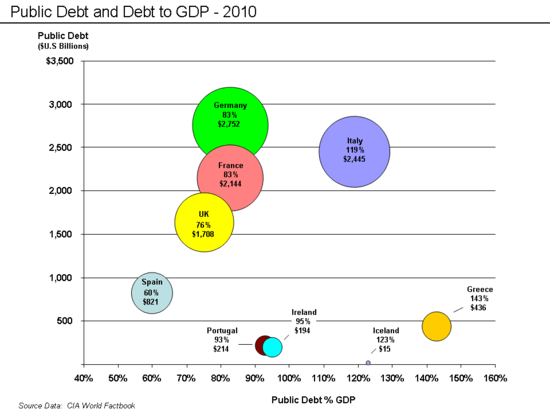Italian government debt
The Italian government debt is the public debt owed by the government of Italy to all public and private lenders. As of January 2014, the Italian government debt stands at €2.1 trillion (131.1% of GDP).[1] However, Italy has the lowest share of public debt held by non-residents of all eurozone countries and the country's national wealth is four times larger than its public debt.[2]
History and government action

2010
Italy ran a budget deficit of 4.6% of GDP in 2010. Italian debt was almost 120% of GDP ($2.4 trillion in 2010).[3] This led investors to view Italian debt bonds as a risky asset.[4]
2011
On 15 July and 14 September 2011, Italy's government passed austerity measures meant to save €124 billion.[5][6] On 8 November 2011 the Italian bond yield was 6.74% for 10-year bonds, climbing above the 7% level where the country is thought to lose access to financial markets.[7]
On 11 November 2011, Italian 10-year borrowing costs fell sharply from 7.5% to 6.7% after Italian legislature approved further austerity measures and the formation of an emergency government to replace that of Prime Minister Silvio Berlusconi.[8]
The measures include a pledge to raise €15 billion from real-estate sales over the next three years, a two-year increase in the retirement age to 67 by 2026, opening up closed professions within 12 months and a gradual reduction in government ownership of local services.[4] The interim government expected to put the new laws into practice was led by former European Union Competition Commissioner Mario Monti.[4]
2012
Government debt reached 127.0% of GDP in 2012.[9]
2013
Government debt reached 130.4% of GDP in 2013.[9]
2014
Government debt reached 131.1% of GDP in 2014.[10]
The Italian government has sought to privatise government assets in 2014 in order to reduce debt, including a sale of the Italian government's minority stake of Poste Italiane stock.[1]
In January 2014 the Italian government also agreed to offer citizens a chance to use a new voluntary disclosure scheme to repatriate assets held abroad, often in Swiss banks.[1] Italy has offered several tax amnesties over the past few years, and a tax amnesty in 2012 resulted in €100 billion in assets being declared and made legal at a steeply discounted tax rate.[1] In 2014, the Bank of Italy estimated that Italians held €180 billion in undeclared assets abroad, a figure that was three times as high as in 2004.[1]
See also
Europe:
References
- 1 2 3 4 5 Emsden, Christopher; Zampano, Giada (January 24, 2014). "Italy's Letta Says Poste Sale Will Help Cut Public Debt". The Wall Street Journal.
- ↑ Claudio Celio (15 November 2014). "Italy has lowest share of public debt held by non-residents". Il Sole-24 Ore.
- ↑ "CIA Factbook-Italy". Central Intelligence Agency. Retrieved 2012-05-14.
- 1 2 3 Migliaccio, Alessandra (11 November 2011). "Italy Senate Vote Makes Way for Government Led by Monti". Bloomberg. Retrieved 11 November 2011.
- ↑ "EU austerity drive country by country". BBC. 22 September 2011. Retrieved 9 November 2011.
- ↑ "Italy parliament gives final approval to austerity plan". Reuters. 14 September 2011. Retrieved 9 November 2011.
- ↑ "Berlusconi to resign after parliamentary setback". Reuters. 8 November 2011. Retrieved 9 November 2011.
- ↑ Moody, Barry (11 November 2011). "Italy pushes through austerity, US applies pressure". Reuters. Retrieved 11 November 2011.
- 1 2 N.A. (16 September 2013). "Italy to hike 2014 debt forecast to 132.2 pct of GDP - draft". Reuters.
- ↑ "Conti Nazionali". www.istat.it (in Italian). ISTAT. Retrieved 22 December 2015.
